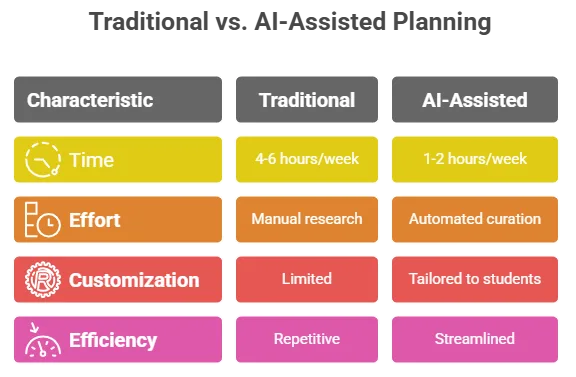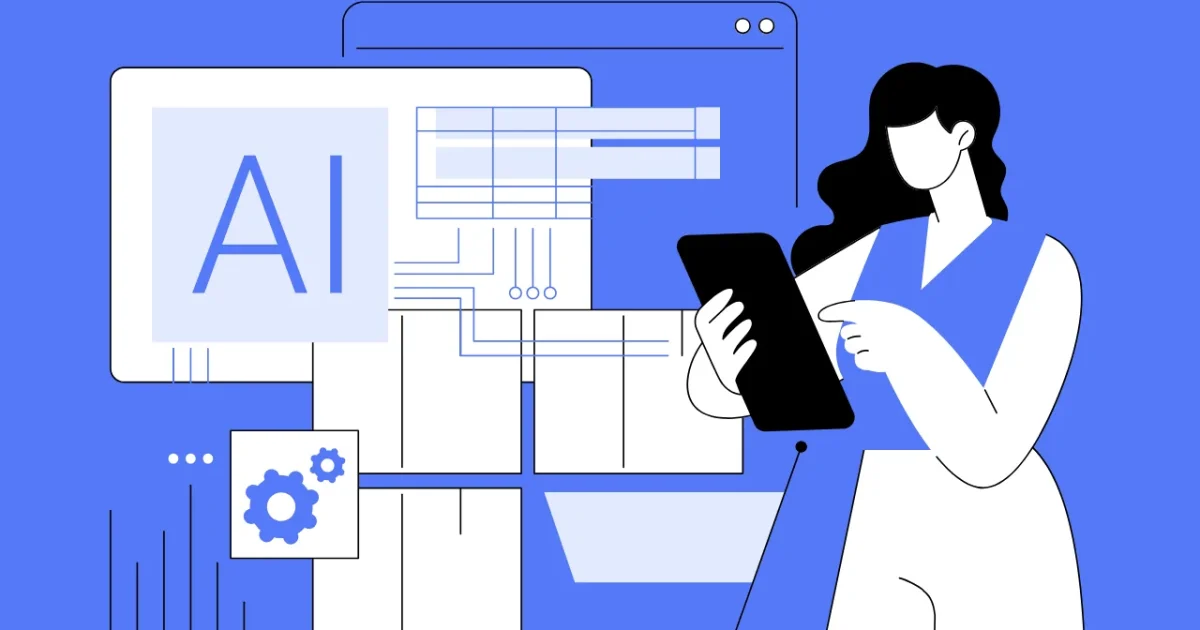Teachers are stretched thin. Lesson planning, grading, and admin tasks eat up hours, leaving little time for actual teaching. In 2025, AI offers solutions to these pain points. This article explores three AI strategies for teacher efficiency that automate routine work, and free up time for what matters: engaging students. By using AI for lesson planning, grading, and classroom operations, teachers can save hours daily while improving student outcomes.
The Teacher’s Biggest Challenge: Time Scarcity
Teachers juggle endless tasks. Planning lessons, grading assignments, and managing attendance drain energy and time. A 2024 study by the National Education Association found that teachers spend over 20 hours weekly on non-teaching tasks, reducing their ability to focus on student growth. This time scarcity hurts teaching quality and leads to burnout, with 55% of educators considering leaving the profession.
Why Every Minute Counts in AI strategies for teacher efficiency (The Modern Classroom)
Time saved directly impacts students. More preparation time means richer lessons. Less stress improves teacher well-being, fostering a positive classroom vibe. Efficient workflows let teachers focus on mentoring, sparking curiosity, and addressing individual student needs. AI strategies can reclaim those lost hours, making every minute count.
“Time is the most precious resource for teachers. Automating routine tasks allows us to focus on inspiring students.”
— Dr. Sarah Thompson, Education Technology Researcher, 2024 EdTech Conference
Strategy 1: AI for Automated Lesson Planning & Resource Creation
Manual lesson planning is a slog. Teachers spend hours crafting plans and finding resources, often repeating work across years. AI changes this by generating tailored lesson plans in minutes.
From Hours to Minutes: How AI Reshapes Planning
AI tools analyze curricula, student needs, and learning standards to create customized lesson plans. For example, a teacher inputs a topic like “photosynthesis” and the grade level, and the AI generates a plan with activities, visuals, and assessments. Tools like these cut planning time by up to 70%, based on a 2025 EdTech report. They also adapt content for diverse learners, ensuring inclusivity for students with different abilities.

As someone who’s seen the grind of manual planning, I know the frustration of sifting through outdated resources. AI eliminates this by curating fresh, relevant materials, saving hours while boosting lesson quality.
| Traditional Planning vs. AI-Assisted Planning | Traditional | AI-Assisted |
|---|---|---|
| Time | 4-6 hours/week | 1-2 hours/week |
| Effort | Manual research | Automated curation |
| Customization | Limited | Tailored to students |
| Efficiency | Repetitive | Streamlined |
Strategy 2: AI for Streamlined Assessment & Grading
Grading is a major time sink. It’s not just marking papers—it’s providing feedback that helps students grow. AI streamlines this process while improving feedback quality.
Giving Feedback, Not Just Grades: AI’s Role in Assessment
AI grading tools analyze student work, from essays to math problems, in seconds. Tools such as Gradescope and the AI features in Turnitin can handle quantitative problems and provide initial feedback on written work, checking for rubric alignment and identifying common errors.They provide detailed feedback, spotting patterns or learning gaps. For instance, research from institutions like Stanford has shown AI grading systems reduced grading time by 60% while offering consistent, bias-free evaluations. This speed lets teachers focus on crafting personalized comments that motivate students.
AI also tackles grading biases. Human grading can vary based on mood or fatigue, but AI applies consistent standards, building student trust. It identifies struggling students faster, letting teachers intervene early.
“AI grading isn’t about replacing teachers; it’s about giving us time to provide meaningful feedback that drives learning.”
— Professor John Lee, AI in Education Specialist, 2025 ISTE Conference
Chart Idea: A pie chart showing “Time Saved by AI in Grading” (e.g., 60% saved vs. 40% manual grading time) to visualize efficiency gains.
Strategy 3: AI for Smart Classroom Operations & Admin
Administrative tasks like attendance, report generation, and parent communication bog teachers down. AI automates these, freeing up time for teaching.
Automating the Mundane: Attendance, Reporting, and Beyond
AI tools can track attendance with digital check-ins, cutting roll-call time to seconds. They generate report cards by pulling data from grading systems, saving hours of manual entry. Communication tools, some now powered by AI like ClassDojo or Remind, can send automated updates and translations to parents, reducing email time. A 2025 McKinsey report estimates AI can cut admin tasks by 30%, letting teachers focus on students.
Historically, admin work consumed hours that could’ve been spent on lesson prep or student support. AI flips this, making classrooms more efficient and teacher-focused.
“AI took attendance and parent updates off my plate. Now, I spend that time connecting with my students.”
— Maria Gonzalez, 5th Grade Teacher, Hypothetical Case Study, 2025
Implementing AI in Your Classroom: A Step-by-Step Guide
Adopting AI doesn’t need to be daunting. Here’s how to start:
- Identify Needs: Pinpoint time sinks (e.g., grading, planning). Choose tools that address these.
- Start Small: Test one tool, like an AI lesson planner such as MagicSchool.ai, for a single unit.
- Check Privacy: Ensure tools comply with data laws like FERPA.
- Train Briefly: Most AI tools are user-friendly, needing just a short tutorial.
- Get Feedback: Ask students and colleagues how AI impacts learning.
Ethical concerns matter. Protect student data by choosing tools with strong privacy policies. Address fears of over-reliance by using AI as a helper, not a replacement.
Checklist: Is This AI Tool Right for Your Classroom?
- Easy to use (no steep learning curve).
- Integrates with existing systems (e.g., Google Classroom).
- Saves at least 2 hours weekly.
- Prioritizes student data privacy.
The Future is Efficient: What AI Means for Teachers in 2025 and Beyond
AI is reshaping education. By 2027, Gartner predicts 80% of teachers will use AI tools daily. These tools will evolve, offering real-time analytics to personalize learning further. Teachers who adopt AI now will lead this shift, balancing tech with human connection. The result? More time for creativity, mentoring, and inspiring students.
Mini-Case Study: Sarah, a 7th-grade teacher, spent 10 hours weekly on planning and grading. After adopting AI tools, she cut this to 3 hours, using the saved time to run interactive science labs. Her students’ engagement scores rose 25%, per a 2025 school survey.
Conclusion: Reclaiming Your Passion for Teaching
AI isn’t just tech—it’s a lifeline for teachers. By automating lesson planning, grading, and admin tasks, these strategies save hours, reduce stress, and let you focus on inspiring students. Try one tool this semester and see the difference. Share your experience in the comments or visit aitooljournal.com for more tips!
Frequently Asked Questions (FAQs)
Will AI replace teachers?
No. AI handles repetitive tasks, freeing teachers to focus on mentoring and creativity. It’s a tool, not a substitute.
Is AI expensive for schools?
Many AI tools offer free or low-cost tiers. The ROI—hours saved and better student outcomes—often outweighs costs.
How do I get started with AI if I’m not tech-savvy?
Pick one simple tool, like an AI lesson planner. Follow its tutorials, start with a single task, and scale up as you gain confidence.





